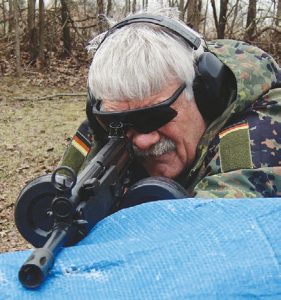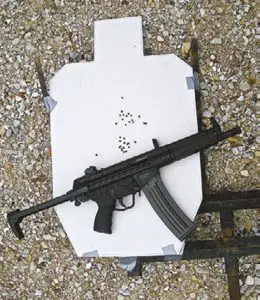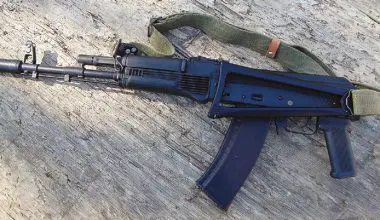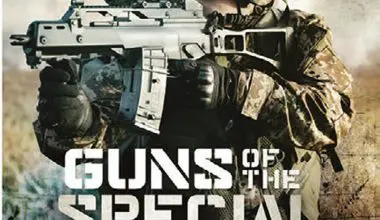I’VE been working on a book on the G3 Battle Rifle, and recently it was time to do the section on the HK33, the 5.56x45mm version of the G3. This version has seen a lot of service use, especially in Asia and Latin America.
Although I have had some experience with the HK33, and quite a bit with the HK53 (the short-barreled carbine version), I did not have ready access to one to handle while writing.
This entailed a visit to the deep recesses of the back of my safe, where I had not ventured for years, to retrieve my HK93, the semi-auto version of the HK33. Far fewer HK93s than HK91s were imported prior to the “assault rifle ban,” so the rifle is less commonly encountered, though Century Arms and some other companies have produced clones using parts kits.
Oddly enough, I bought mine at the height of the Clinton gun ban, when HK93s were bringing a steep premium. One had just come into a local gun shop in trade and my friend the dealer wanted to turn it into cash quickly, so he offered me a good deal, which I took.




As I remember, I took it out to the range a couple of times after I got it more than ten years ago, then stored it because I was doing most of my 5.56x45mm shooting either with an AR-15 or my SIG 551A1.
Before I put the HK93 in the safe, where it began its migration to a dark rear corner, I did buy extra surplus magazines and, when the ban lifted, I quickly bought a 100-round Beta-C mag for the rifle.
I figured while the Beta-Cs were available again, I should buy one for my HK93 and one for my Steyr AUG. I already had one for my AR-15.
When I dug out my HK93 for use in the G3 book, I was reminded how much I like it. It isn’t exactly like an HK33. Obviously, it has the two-position rather than the three-position selector and it has a button magazine release, while the HK33 has the flipper style. But otherwise, it’s close.
It certainly allowed me to shoot it as a reminder of using the HK33 and to evaluate it in the section of the book on the semi-auto versions. One of the first things I re-noticed was how much handier and livelier the HK93A2 is compared to the HK91A2. Unloaded, the HK93A2 is about three pounds lighter. The A3 version of each is about .75 pound heavier because of the steel collapsible stock.
The weight of loaded magazines for each also affects overall weight: for the HK91, a full 20-round magazine of 7.62x51mm NATO weighs approximately 26.5 ounces, while for the HK93, a full 25-round magazine of 5.56x45mm SS109 weighs approximately 20 ounces.
About 30 countries eventually adopted some form of the HK33. In some cases, they had previously used the G3 and wanted something lighter chambered for the 5.56x45mm cartridge. The military HK33A2 had a 15.4-inch barrel and the HK33A3 a 13.1-inch barrel. Standard barrel length for the HK93A2 was 17.1 inches. I’m sure some have been registered as SBRs with shorter barrels. The C93 that Century Arms used to make was available with a 16.25-inch barrel.

Many of the countries actually adopted the HK33 carbine version— the HK53. This is an excellent weapon that has been used by many elite special ops units, including Britain’s SAS and SBS, Hong Kong’s Special Duties Unit (SDU), and Ireland’s Army Ranger Wing (ARW) and Garda Emergency Response Unit (ERU). For years, I recommended it to close protection teams as an alternate to the MP5 because it gave greater range and striking power.
All these select-fire or semi-auto versions of the HK33 offered the same magazine choices. Based on a quick check of prices, the 25-round H&Kmanufactured magazines are bringing a hefty amount these days.
Far more common are the 40-round magazines from Malaysia. Based on firing at least 1,000 rounds through the 40-round magazines, they perform reliably. My only problem with them is that they protrude so far below the receiver that going prone is difficult without rolling to the side to fire. They would also be likely to snag going through heavy brush, etc.
Actually, the 100-round Beta-C mag allows going prone or use of low cover more readily, though it is heavier. I know of other magazines that have been made for the HK33 that function in the HK93 and other variants. In addition to the standard 25-round magazine, H&K also made 20- and 30-rounders and even five-round ones.

MKE, the Turkish manufacturer of HK products, made plastic magazines, I think with 30-round capacity. ProMag also makes plastic 20-, 30-, and 40-round magazines. I have not used any of the plastic magazines, not because I don’t like them, but because I bought steel or aluminum mags back when they were relatively inexpensive. They work, so I haven’t seen any need to change.
CETME made its own Model L, which resembles the HK33 but does not have parts interchangeability. The Spanish armed forces used it from the late 1980s until they replaced it with the HK G36 in 1999. The Model L used STANAG 30-round M16 magazines, so they would not be compatible with the HK93.
Far more readers will own an HK91 or CETME 7.62x51mm rifle or clone than an HK93 or clone. But I think most of those who do own an HK93, a Century C93, or, if very lucky, a registered HK53, will be fans as I am.
Working on the G3 book, I’ve lugged my HK91A2 and, after switching stocks, my HK91A3 around doing shooting tests. On the range day I spent with the HK93, I found the lighter and handier rifle a joy.
Don’t get me wrong: I appreciate the advantages of the HK91/G3 as a battle rifle, but it’s heavy! They actually make a 7.62x51mm Beta-C mag for the HK91/G3. I’ve never tried one, but would not want to hump the rifle around with it in place. Shooting from a static position, I would probably appreciate the Beta-C mag.
Even with the Beta-C mag in place, I find the HK93 well balanced, though it does get heavy firing offhand after a while. But the weight distribution with the Beta-C balances well. Although I bought some 40-round magazines for my HK93, I mostly use it with the 25 rounders. If I wanted more rounds, I would choose the Beta-C mag.
Summing up, I have rediscovered how much I like the HK93. They are not too common these days and are expensive, but are really nice rifles.
I’m leaving mine toward the front of the safe, so I can shoot it more.





